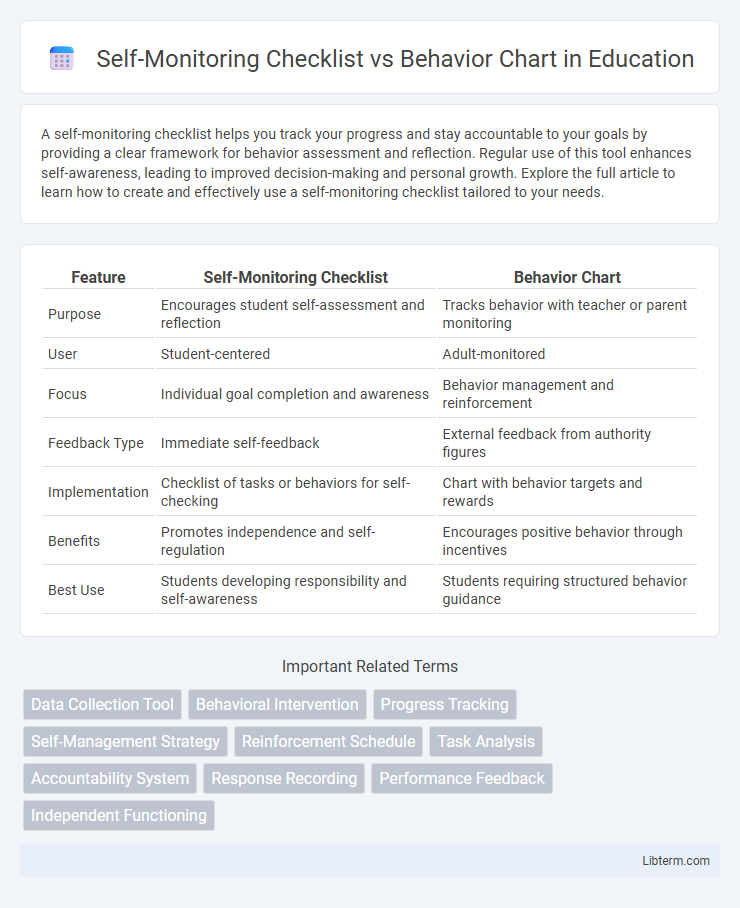A self-monitoring checklist helps you track your progress and stay accountable to your goals by providing a clear framework for behavior assessment and reflection. Regular use of this tool enhances self-awareness, leading to improved decision-making and personal growth. Explore the full article to learn how to create and effectively use a self-monitoring checklist tailored to your needs.
Table of Comparison
| Feature | Self-Monitoring Checklist | Behavior Chart |
|---|---|---|
| Purpose | Encourages student self-assessment and reflection | Tracks behavior with teacher or parent monitoring |
| User | Student-centered | Adult-monitored |
| Focus | Individual goal completion and awareness | Behavior management and reinforcement |
| Feedback Type | Immediate self-feedback | External feedback from authority figures |
| Implementation | Checklist of tasks or behaviors for self-checking | Chart with behavior targets and rewards |
| Benefits | Promotes independence and self-regulation | Encourages positive behavior through incentives |
| Best Use | Students developing responsibility and self-awareness | Students requiring structured behavior guidance |
Understanding Self-Monitoring Checklists
Self-monitoring checklists are tools designed to help individuals track and assess their own behaviors and progress toward specific goals, promoting self-awareness and accountability. Unlike behavior charts that primarily provide external visual reinforcement, self-monitoring checklists empower users to independently evaluate their actions, fostering intrinsic motivation and personal responsibility. Research highlights that self-monitoring checklists enhance executive functioning skills by improving attention to detail and facilitating goal-directed behavior in academic and therapeutic settings.
What Is a Behavior Chart?
A behavior chart is a visual tool used to track and reinforce desired behaviors in children by providing clear expectations and immediate feedback. It typically involves marking progress through stickers, stars, or points that motivate consistent positive actions and accountability. Behavior charts help teachers and parents promote self-regulation and improve conduct by making goals tangible and encouraging incremental achievement.
Key Differences Between Self-Monitoring Checklists and Behavior Charts
Self-monitoring checklists empower individuals to track their own behaviors and progress, fostering self-awareness and autonomy in behavior management. Behavior charts, typically managed by teachers or caregivers, provide external monitoring with visual rewards or consequences to encourage desired behaviors. The key difference lies in self-regulation versus external regulation, affecting motivation and accountability in behavior modification strategies.
Benefits of Using Self-Monitoring Checklists
Self-monitoring checklists empower individuals to independently track their own behaviors, fostering self-awareness and accountability. These tools promote consistent progress by enabling users to identify patterns and make timely adjustments without external intervention. Research highlights that self-monitoring boosts intrinsic motivation and supports sustained behavioral change more effectively than behavior charts often reliant on external rewards.
Advantages of Behavior Charts in Behavior Management
Behavior charts offer clear visual feedback and immediate reinforcement, which enhance motivation and accountability in behavior management. They enable consistent tracking of specific behaviors, making it easier for caregivers and educators to identify patterns and adjust interventions promptly. The structured format of behavior charts supports positive reinforcement strategies, promoting lasting behavior change more effectively than self-monitoring checklists.
When to Use Self-Monitoring Checklists
Self-monitoring checklists are most effective when individuals need to increase awareness and control over their own behaviors, particularly in educational or therapeutic settings where self-regulation is a goal. They work well for tasks requiring frequent self-assessment, such as tracking study habits, emotional responses, or compliance with treatment plans. Behavior charts are better suited for external motivation and visual reinforcement, while self-monitoring checklists empower users to independently recognize progress and identify areas needing improvement.
Situations Ideal for Behavior Charts
Behavior charts are ideal for situations requiring clear, consistent reinforcement of specific behaviors in children or students, such as classroom settings or home routines. They effectively track progress on targeted actions like completing homework, following rules, or practicing good manners. Behavior charts provide immediate visual feedback, promoting motivation and accountability in structured environments.
Combining Self-Monitoring Checklists and Behavior Charts
Combining self-monitoring checklists and behavior charts enhances behavior management by fostering student accountability and providing visual progress tracking. Self-monitoring checklists empower students to independently assess their actions, while behavior charts offer immediate feedback and reinforcement for positive behavior changes. Integrating both tools creates a comprehensive system that supports goal-setting, motivation, and consistent behavioral improvements.
Tips for Effective Implementation
Implementing a self-monitoring checklist requires clear, measurable criteria and consistent review intervals to empower individuals in tracking their own behaviors effectively. Behavior charts work best when paired with immediate, specific feedback and tangible rewards to reinforce positive actions. Combining these tools with regular goal-setting and reflection sessions enhances motivation and accountability for sustained behavioral improvement.
Choosing the Right Tool for Student Success
Selecting between a self-monitoring checklist and a behavior chart hinges on the student's level of self-awareness and motivation; checklists foster independence by encouraging self-assessment, while behavior charts provide external reinforcement through tangible rewards or consequences. For students who benefit from immediate feedback and structured guidance, behavior charts serve as effective tools to track progress and shape positive habits. Emphasizing individualized needs and educational goals ensures the chosen tool maximizes engagement, accountability, and long-term behavioral improvement.
Self-Monitoring Checklist Infographic

 libterm.com
libterm.com